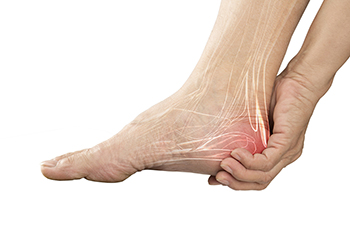Connect With Us
Blog

Heel pain is a common concern that can interrupt daily movement and make each step feel heavier than the last. One frequent cause is plantar fasciitis, which develops when the band of tissue along the bottom of the foot becomes irritated. Other sources include Achilles tendon strain, inflammation in the heel pad, nerve irritation, or bursitis that forms from repeated pressure. Some individuals notice discomfort after long hours on hard surfaces, while others develop pain from sudden increases in activity or shoes that lack support. Early attention helps prevent the condition from becoming chronic. Resting the foot, improving footwear, gentle stretching, and targeted care can ease symptoms and encourage healing. If you have heel pain, it is suggested that you see a podiatrist for a diagnosis and appropriate treatment options.
Many people suffer from bouts of heel pain. For more information, contact Richard M. Allen, DPM of Idaho. our doctor can provide the care you need to keep you pain-free and on your feet.
Causes of Heel Pain
Heel pain is often associated with plantar fasciitis. The plantar fascia is a band of tissues that extends along the bottom of the foot. A rip or tear in this ligament can cause inflammation of the tissue.
Achilles tendonitis is another cause of heel pain. Inflammation of the Achilles tendon will cause pain from fractures and muscle tearing. Lack of flexibility is also another symptom.
Heel spurs are another cause of pain. When the tissues of the plantar fascia undergo a great deal of stress, it can lead to ligament separation from the heel bone, causing heel spurs.
Why Might Heel Pain Occur?
- Wearing ill-fitting shoes
- Wearing non-supportive shoes
- Weight change
- Excessive running
Treatments
Heel pain should be treated as soon as possible for immediate results. Keeping your feet in a stress-free environment will help. If you suffer from Achilles tendonitis or plantar fasciitis, applying ice will reduce the swelling. Stretching before an exercise like running will help the muscles. Using all these tips will help make heel pain a condition of the past.
If you have any questions, please feel free to contact our office located in Lewiston, ID . We offer the newest diagnostic and treatment technologies for all your foot care needs.

Regular foot care helps keep you moving comfortably and prevents small issues from becoming painful problems. Clean your feet daily with warm water, then dry them well, especially between the toes, where moisture can linger. A gentle moisturizer keeps the skin soft, but avoid applying it between the toes to prevent irritation. Keeping toenails trimmed straight across helps reduce the chance of ingrown nails. Choosing shoes that fit well and offer good support protects your arches and reduces pressure points during daily activities. Inspecting your feet regularly allows you to notice changes early. Look for redness, swelling, thickened nails, or areas that feel tender. These small checks are especially important if you have diabetes or circulation concerns. When something feels off, early guidance can prevent long-term complications. If you notice persistent foot pain, skin changes, or have difficulty walking, it is suggested that you see a podiatrist for an evaluation and appropriate treatment.
Everyday foot care is very important to prevent infection and other foot ailments. If you need your feet checked, contact Richard M. Allen, DPM from Idaho. our doctor can provide the care you need to keep you pain-free and on your feet.
Everyday Foot Care
Often, people take care of their bodies, face and hair more so than they do for their feet. But the feet are a very important aspect of our bodies, and one that we should pay more attention to. Without our feet, we would not be able to perform most daily tasks.
It is best to check your feet regularly to make sure there are no new bruises or cuts that you may not have noticed before. For dry feet, moisturizer can easily be a remedy and can be applied as often as necessary to the affected areas. Wearing shoes that fit well can also help you maintain good foot health, as well as making it easier to walk and do daily activities without the stress or pain of ill-fitting shoes, high heels, or even flip flops. Wearing clean socks with closed shoes is important to ensure that sweat and bacteria do not accumulate within the shoe. Clean socks help to prevent Athlete’s foot, fungi problems, bad odors, and can absorb sweat.
If you have any questions, please feel free to contact our office located in Lewiston, ID . We offer the newest diagnostic and treatment technologies for all your foot care needs.

A broken foot occurs when one or more of the 26 bones in the foot fracture due to injury or stress. These bones include the metatarsals, phalanges, tarsals, and heel bone, all of which are vital to balance and mobility. A break can result from accidents, falls, sports injuries, or dropping something heavy on the foot. Symptoms vary depending on severity but often include sudden pain, swelling, bruising, and an inability to bear weight. In severe cases, the bone may protrude through the skin or cause visible deformity. People with improper footwear or weakened bones are more likely to experience foot fractures. A podiatrist can help by ordering X-rays to determine the location and extent of the injury and recommend appropriate treatment, which may involve immobilization or surgery. If you have broken a bone in the foot, it is suggested that you make an appointment with a podiatrist for a diagnosis and guidance on returning to activities.
A broken foot requires immediate medical attention and treatment. If you need your feet checked, contact Richard M. Allen, DPM from Idaho. our doctor can provide the care you need to keep you pain-free and on your feet.
Broken Foot Causes, Symptoms, and Treatment
A broken foot is caused by one of the bones in the foot typically breaking when bended, crushed, or stretched beyond its natural capabilities. Usually the location of the fracture indicates how the break occurred, whether it was through an object, fall, or any other type of injury.
Common Symptoms of Broken Feet:
- Bruising
- Pain
- Redness
- Swelling
- Blue in color
- Numbness
- Cold
- Misshapen
- Cuts
- Deformities
Those that suspect they have a broken foot shoot seek urgent medical attention where a medical professional could diagnose the severity.
Treatment for broken bones varies depending on the cause, severity and location. Some will require the use of splints, casts or crutches while others could even involve surgery to repair the broken bones. Personal care includes the use of ice and keeping the foot stabilized and elevated.
If you have any questions, please feel free to contact our office located in Lewiston, ID . We offer the newest diagnostic and treatment technologies for all your foot care needs.

